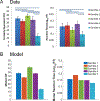The PRO model accounts for the anterior cingulate cortex role in risky decision-making and monitoring
- PMID: 35332510
- PMCID: PMC11059203
- DOI: 10.3758/s13415-022-00992-3
The PRO model accounts for the anterior cingulate cortex role in risky decision-making and monitoring
Abstract
The anterior cingulate cortex (ACC) has been implicated in a number of functions, including performance monitoring and decision-making involving effort. The prediction of responses and outcomes (PRO) model has provided a unified account of much human and monkey ACC data involving anatomy, neurophysiology, EEG, fMRI, and behavior. We explored the computational nature of ACC with the PRO model, extending it to account specifically for both human and macaque monkey decision-making under risk, including both behavioral and neural data. We show that the PRO model can account for a number of additional effects related to outcome prediction, decision-making under risk, gambling behavior. In particular, we show that the ACC represents the variance of uncertain outcomes, suggesting a link between ACC function and mean-variance theories of decision making. The PRO model provides a unified account of a large set of data regarding the ACC.
Keywords: Computational model; Control; Decision-making; Prefrontal cortex.
© 2022. The Psychonomic Society, Inc.
Figures









Similar articles
-
Distinct portions of anterior cingulate cortex and medial prefrontal cortex are activated by reward processing in separable phases of decision-making cognition.Biol Psychiatry. 2004 Mar 15;55(6):594-602. doi: 10.1016/j.biopsych.2003.11.012. Biol Psychiatry. 2004. PMID: 15013828
-
Roles of Ventromedial Prefrontal Cortex and Anterior Cingulate in Subjective Valuation of Prospective Effort.Cereb Cortex. 2019 Sep 13;29(10):4277-4290. doi: 10.1093/cercor/bhy310. Cereb Cortex. 2019. PMID: 30541111 Free PMC article.
-
Single-trial coupling of EEG and fMRI reveals the involvement of early anterior cingulate cortex activation in effortful decision making.Neuroimage. 2008 Aug 1;42(1):158-68. doi: 10.1016/j.neuroimage.2008.04.236. Epub 2008 Apr 29. Neuroimage. 2008. PMID: 18547820
-
The best of a bad bunch: the ventromedial prefrontal cortex and dorsal anterior cingulate cortex in decision-making.J Neurosci. 2007 Jan 17;27(3):447-8. doi: 10.1523/jneurosci.4967-06.2007. J Neurosci. 2007. PMID: 17240549 Free PMC article. Review. No abstract available.
-
Frontal circuit specialisations for decision making.Eur J Neurosci. 2021 Jun;53(11):3654-3671. doi: 10.1111/ejn.15236. Epub 2021 Apr 29. Eur J Neurosci. 2021. PMID: 33864305 Review.
Cited by
-
Debates on the dorsomedial prefrontal/dorsal anterior cingulate cortex: insights for future research.Brain. 2023 Dec 1;146(12):4826-4844. doi: 10.1093/brain/awad263. Brain. 2023. PMID: 37530487 Free PMC article. Review.
-
Neural evidence of switch processes during semantic and phonetic foraging in human memory.Proc Natl Acad Sci U S A. 2023 Oct 17;120(42):e2312462120. doi: 10.1073/pnas.2312462120. Epub 2023 Oct 12. Proc Natl Acad Sci U S A. 2023. PMID: 37824523 Free PMC article.
-
Mechanisms of adjustments to different types of uncertainty in the reward environment across mice and monkeys.Cogn Affect Behav Neurosci. 2023 Jun;23(3):600-619. doi: 10.3758/s13415-022-01059-z. Epub 2023 Feb 23. Cogn Affect Behav Neurosci. 2023. PMID: 36823249 Free PMC article.
-
The Promise of Behavioral Tracking Systems for Advancing Primate Animal Welfare.Animals (Basel). 2022 Jun 27;12(13):1648. doi: 10.3390/ani12131648. Animals (Basel). 2022. PMID: 35804547 Free PMC article. Review.
References
Publication types
MeSH terms
Grants and funding
LinkOut - more resources
Full Text Sources
Medical

